Did you know there are hundreds of types of purple wildflowers? Purple is one of the most common flower colors. If you feel like you see a ton of purple flowers while on a hike, you’re not alone!
In this article, we’ll list 55 amazing types of purple wildflowers—many of which have several purple species within the genus—and highlight a few standouts worth searching for on your adventures. Don’t miss the full list at the bottom of the article.
Let’s dig in!
Alfalfa
Botanical name: Medicago sativa
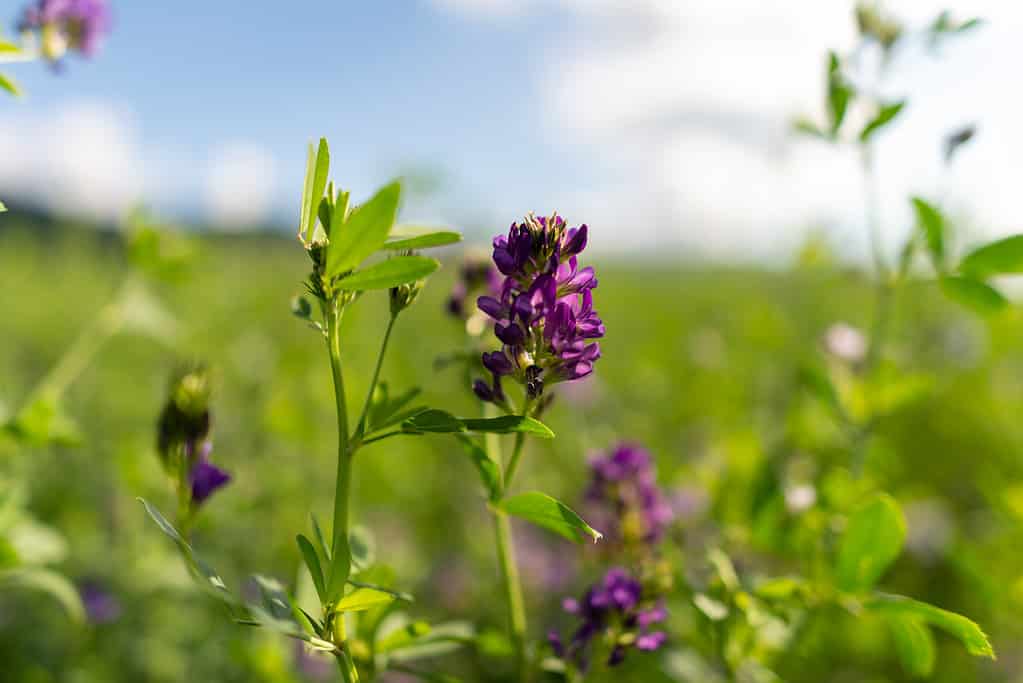
Alfalfa,
Medicago sativa, also called lucerne. It is cultivated as an important forage crop for
farm animals
.
©AndreaObzerova/iStock via Getty Images
This nutritious member of the pea family can be found growing in fields and along coasts all over the world. Growing as tall as 3-4 feet, this resilient perennial branches as it grows, producing clusters of vibrant purple petals at the end of long stems. Some regions call this common wildflower “lucerne.”
Alfalfa is an integral part of agriculture, providing a nutritious snack for grazing livestock. You may have also tried alfalfa sprouts on an artisan sandwich!
American Hog-Peanut
Botanical name: Amphicarpaea bracteata

(American Hog-Peanut) has edible roots but is not a true peanut.
©Brian Woolman/iStock via Getty Images
The American Hog-Peanut is a member of the pea family and one of the most unique wildflowers you might come across in the United States. The most noticeable blooms are the elegantly curled purple petals surrounded by an off-white calyx. You likely won’t notice the other blooms at all—they’re underground!
This unique purple wildflower also has two types of seeds, with the above-ground seeds growing in pea-like pods. Their unique appearance also earned them the name “ground beans.”
Bee Orchid
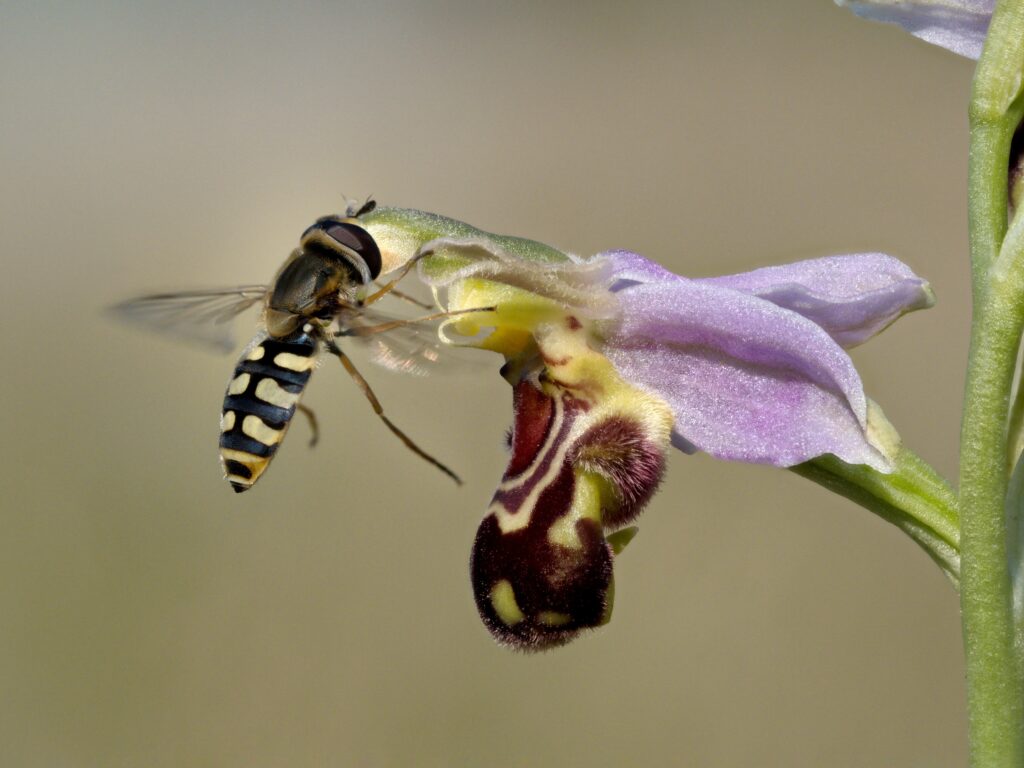
attracts pollinators of all shapes and sizes.
©David Osborn/Shutterstock.com
Botanical name: Ophrys apifera
If you’re familiar with pollinator-friendly flowers, you’ve likely heard of bee balm; the bee orchid is less known.
This beautiful purple wildflower grows primarily in the United Kingdom. It grows in long stalks with three-petaled blossoms up the side. The delicate mauve hue and unique shape are designed to attract pollinators, making it a vital plant to protect and cultivate.
Bull Thistle
Botanical name: Cirsium vulgare

Bull thistle is an invasive species in some areas.
©Yavdat/Shutterstock.com
There are several types of purple wildflowers that look like Bull Thistle. While Canada Thistle is closest, the Common Burdock, Panicled Knapweed, and Saw-Wort also bear a resemblance.
These spiky plants grow in large, thick stalks that are challenging to remove. Their fringed purple blossoms look sharp but are quite delicate. Bull Thistle (and Canada Thistle) are invasive as they drain nutrients from the soil and plants around them. If you see them in your yard, consider removing them.
Clasping Bellflower
Botanical name: Triodanis perfoliata

is North American.
©Brian Woolman/iStock via Getty Images
The Clasping Bellflower also goes by “Clasping Venus’s Looking Glass,” named for its unique shiny seeds encompassed by five opening and closing petals.
These beautiful purple wildflowers grow in tall stalks with tiny blossoms along the sides. The vibrant purple shade often takes on a blue tone, adding to its attractiveness. This wildflower is a favorite among gardeners and pollinators alike!
Common Camas
Botanical name: Camassia quamash
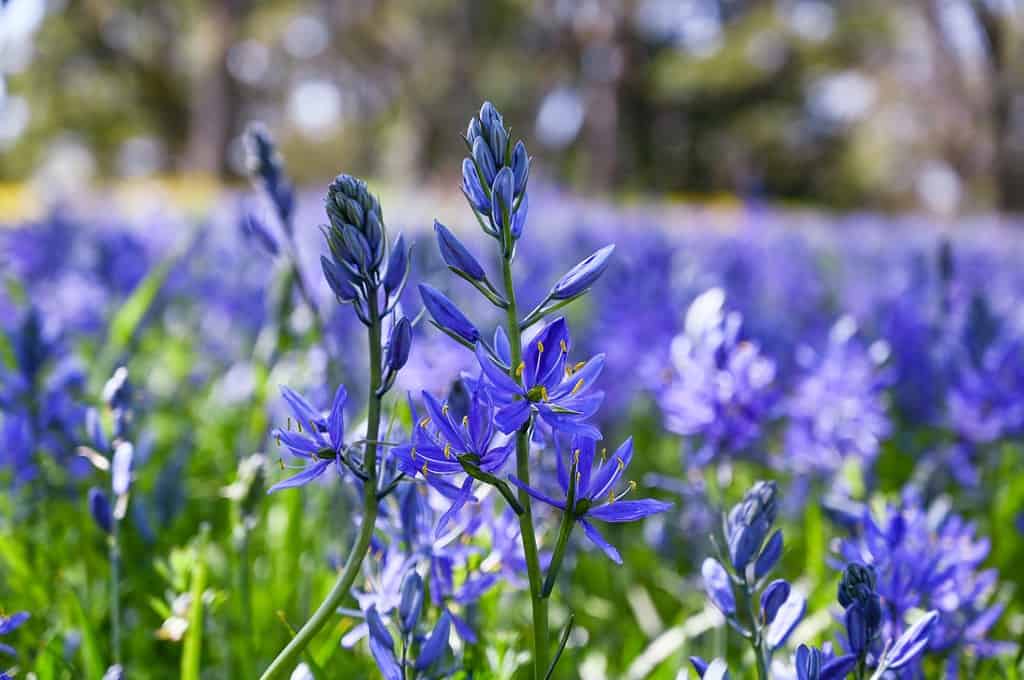
The Common Camas is native to British Columbia, Canada.
©WhisperingOaksPhotography/Shutterstock.com
According to the U.S. Forest Service, the Common Camas has a rich history. This ethereal lavender-blue plant was a hot commodity in the 1800s. Harvesters would ship it from its West Coast home to the East Coast and overseas to England for ornamental display. Indigenous tribes would cook and consume the bulbs for energy.
This stunning wildflower grows in tall stalks with stellate petals, white filaments, and bright yellow anthers.
Corncockle
Botanical name: Agrostemma githago

is also called a corncockle or purple cockle.
©Orthosie/iStock via Getty Images
The Corncockle boasts beautiful flowers ranging from light pink to deep purple. The petals of this herbaceous annual are rotate and symmetrical, with a pale center and deep, eye-catching lines to attract pollinators.
While the Corncockle originated in Europe, it’s become common in North America. These beauties grow no more than 2-3 feet tall, so keep your eyes low to spot them in the wild.
Eastern Coneflower
Botanical name: Echinacea purpurea
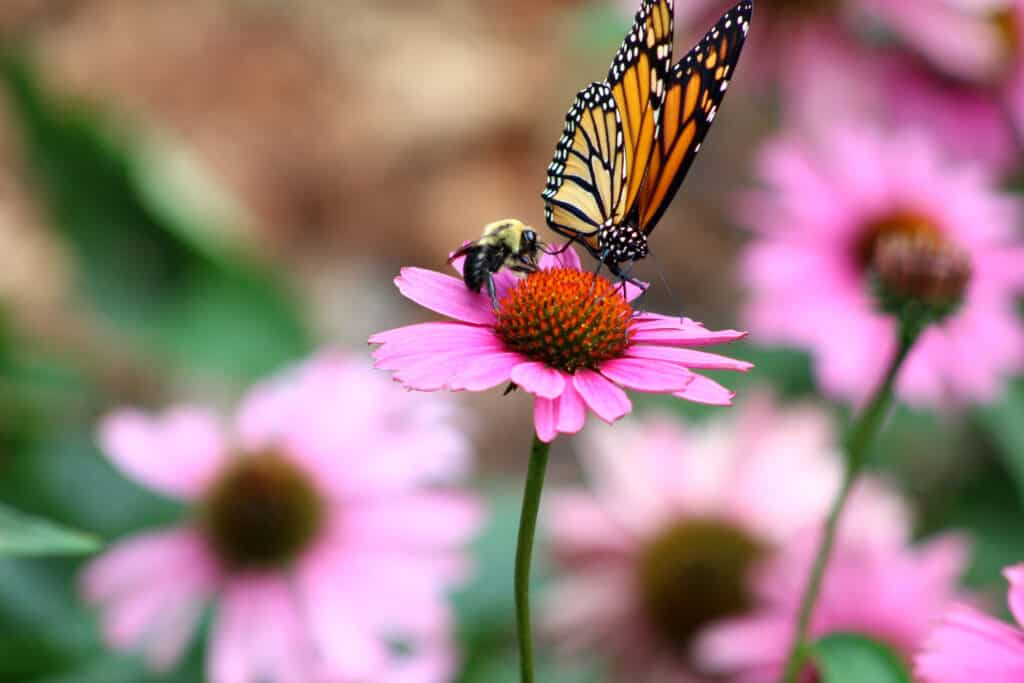
A monarch butterfly and
bumblebee
on the same purple coneflower.
©iStock.com/db_beyer
Coneflowers are another herbaceous flower with a rich history. If you’ve ever taken echinacea supplements to help offset cold and flu season, you’ve benefitted from this plant.
A member of the daisy family, Coneflower petals are pink to purple and are a favorite among pollinators. They grow in clusters, reaching 2-3 feet tall in ideal conditions.
Fairy Slipper
Botanical name: Calypso bulbosa
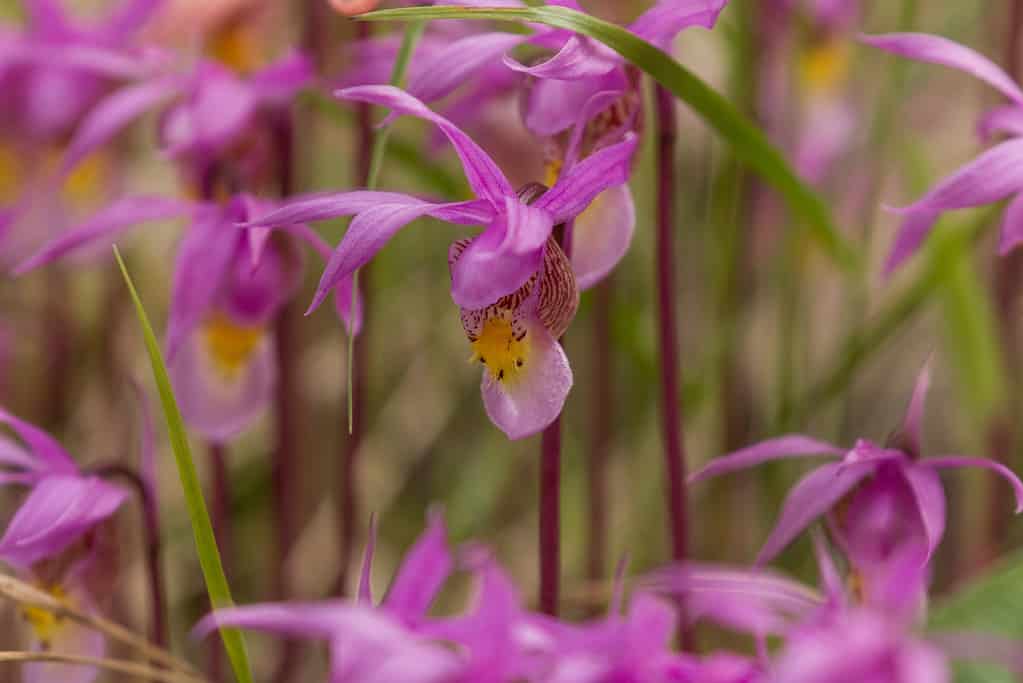
Pink Fairy Slipper Orchids blooming in early summer in Yellowstone National Park.
©mtnmichelle/iStock via Getty Images
Calypso bulbosa is a stunning species of wild orchid. Its petals are zygomorphic (asymmetrical), with a few stellate petals on the top and a larger petal on the bottom. This unique shape is why many call this flower the Fairy Slipper.
This muted pink-purple flower grows in North America, Europe, and parts of Asia. However, it’s rare in the Northern United States, so consider yourself lucky if you stumble upon one (and leave it untouched).
Foxglove
Botanical name: Digitalis purpurea
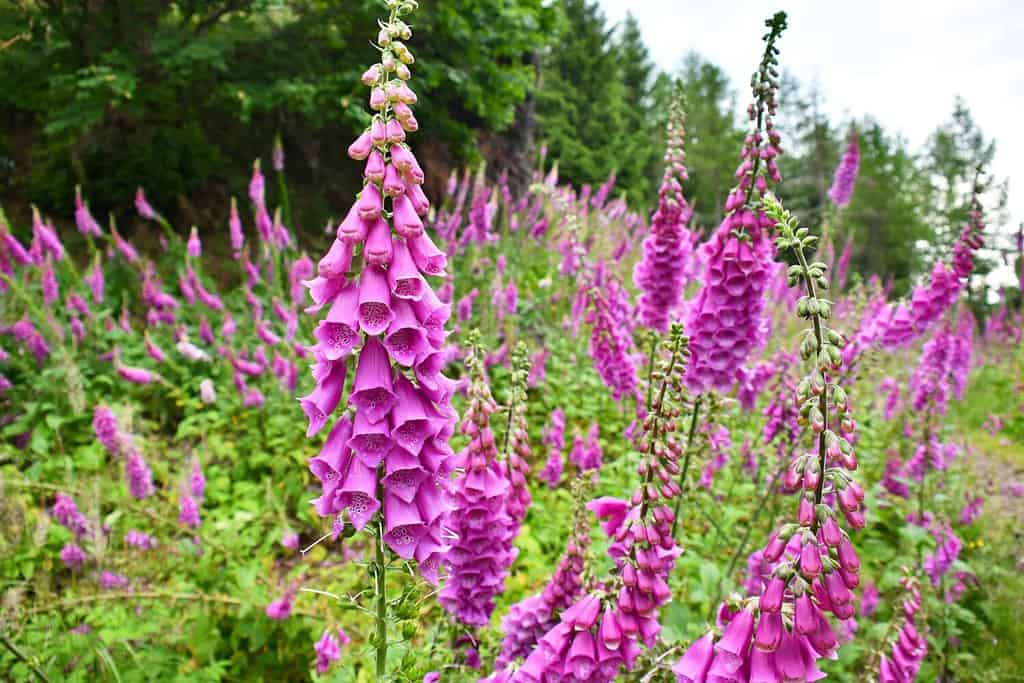
Foxglove is poisonous to pets, so gardeners beware.
©HAL-9000/Shutterstock.com
While there are several types of foxglove, Digitalis purpurea is the most common. These tall stalks have purple bell-shaped blooms that grow in lush clusters. Don’t confuse it with Agalinis purpurea, also known as “False Purple Foxglove,” which has a less defined bell shape and sparser blooms.
This herbaceous wildflower is native to Western Europe, where you’ll see it along mountain paths and wooded clearings.
Grass Widow
Botanical name: Olsynium douglasii
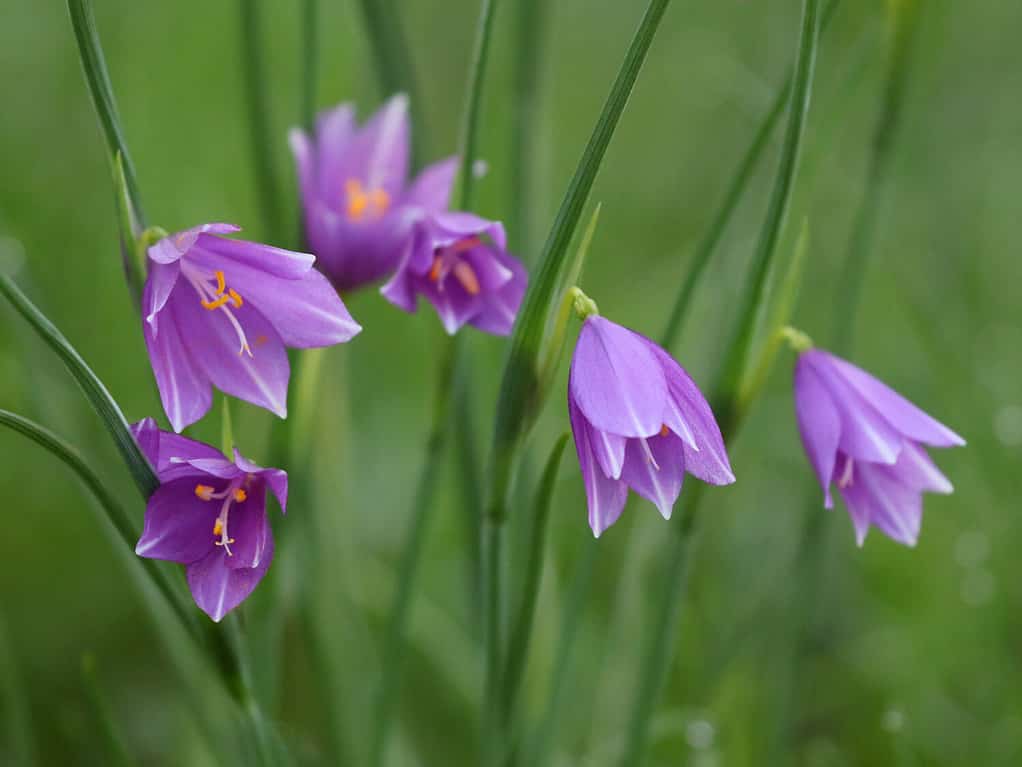
True to their name, Grass Widows prefer to be left alone.
©Randy Bjorklund/Shutterstock.com
The Grass Widow is a beautiful purple bell-shaped wildflower that grows along the West Coast, from California to British Columbia. The name stems from an archaic term referring to a woman who is separated, divorced, or estranged from her (very much alive) husband. Unlike other wildflowers, these plants prefer a bit of space to grow.
While the foliage resembles blades of grass, this flower bears no close relation to grass species. Grass Widow flowers grow no more than 12-15 inches tall, so look low while out on your adventures.
Hedgemaids
Botanical name: Glechoma hederacea
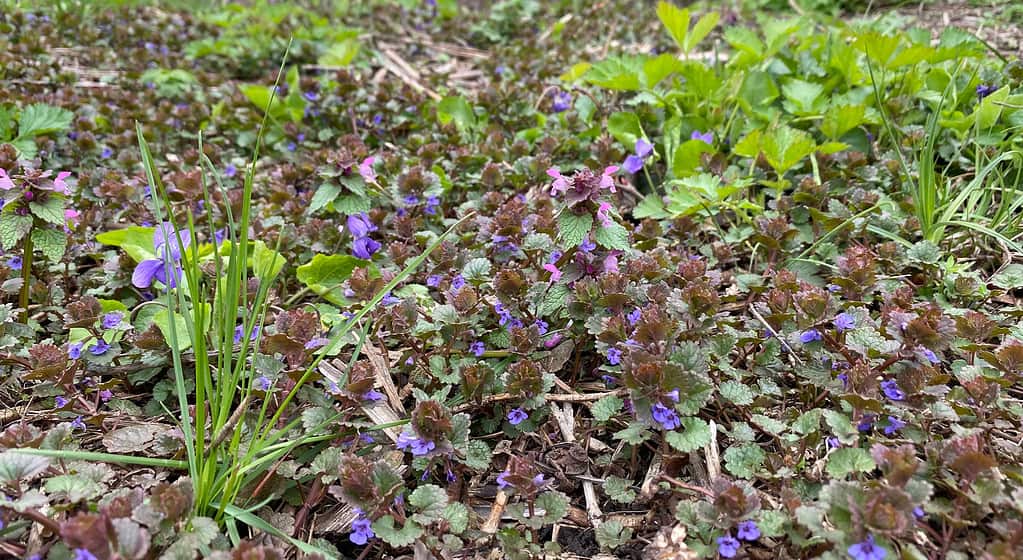
Hedgemaids also go by the names Ground Ivy or Creeping Charlie.
©Olena Lialina/iStock via Getty Images
This fragrant wildflower grows in thick carpets that cover the forest floor and may take over your garden. You may know it as Hedgemaids, Creeping Charlie, or Ground Ivy. This furious grower originates in Europe but was naturalized in North America. It’s now considered invasive in many areas.
You can identify this plant via its green and brown-red foliage and pops of pretty purple petals scattered throughout. If you find it, check with your local forestry office to report it and see if any action is needed.
Monkeyflower
Botanical name: Erythranthe lewisii syn. Mimulus lewisii
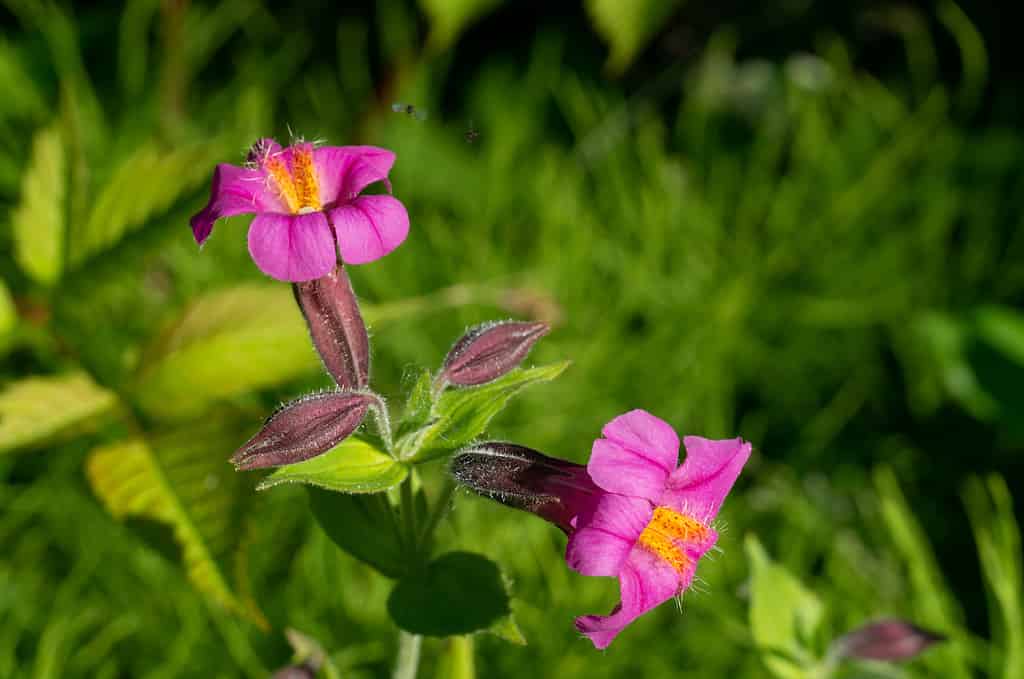
A selective focus shot of the beautiful great purple monkeyflower.
©Wirestock/iStock via Getty Images
Monkeyflowers come in a variety of shades and sizes. Named for their apparent resemblance to a monkey’s face, these whimsical blooms have purple petals with a bright yellow-orange “tongue.” You’ll recognize them by their contrasting shades and asymmetrical petal structure.
This purple wildflower is prevalent along the West Coast, spanning from California to Alaska.
Mother-of-the-Evening
Botanical name: Hesperis matronalis

In the evenings, the scent of the Dame’s Rocket (
Hesperis matronalis) flowers becomes stronger.
©iStock.com/Olena Lialina
Mother-of-the-Evening, also called the Dame’s Rocket, is a European wildflower native to the Mediterranean region. This fragrant flower grows in thick stalks with cruciform purple petals boasting a delicate white and yellow center.
Many describe this lovely flower’s scent as sweet and bright. Don’t be surprised if you notice the fragrance before you spot the blooms on an evening stroll.
Purple Prarie Clover
Botanical name: Dalea purpurea
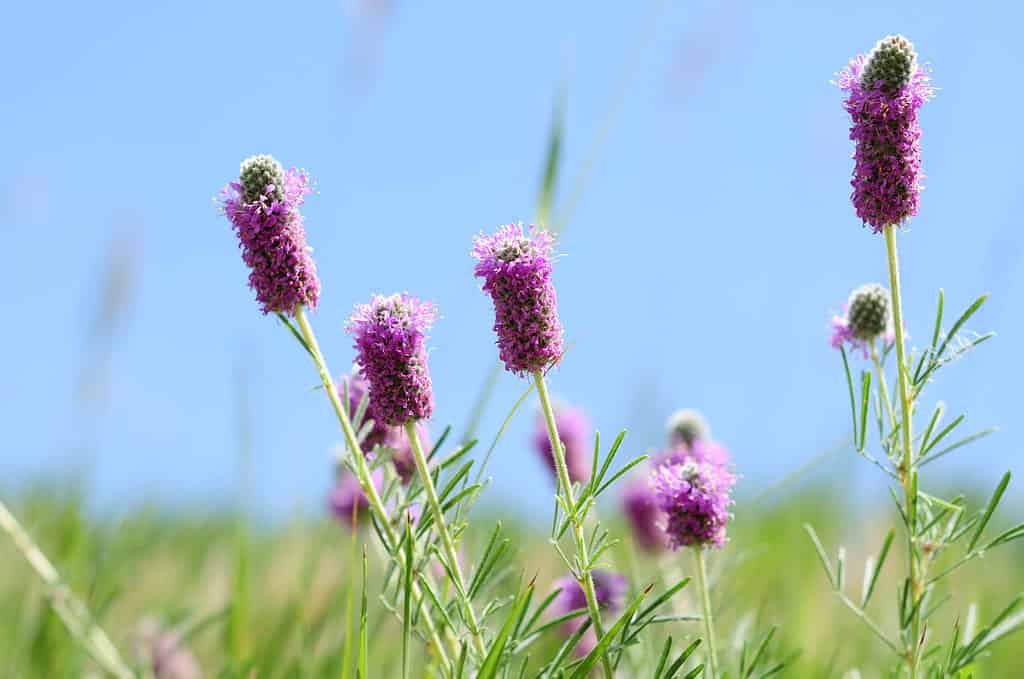
have unique, cylindrical heads and delicate purple blooms.
©Sean Xu/Shutterstock.com
This unique purple wildflower stands apart from other clovers, boasting a unique cylindrical head and tiny blossoms that bloom from bottom to top. Its foliage is reminiscent of rosemary or thyme, but this wildflower is actually a member of the legume family.
You’ll discover these prairie flowers across North America, swaying soothingly in fields and plains.
Sea Holly
Botanical name: Eryngium planum
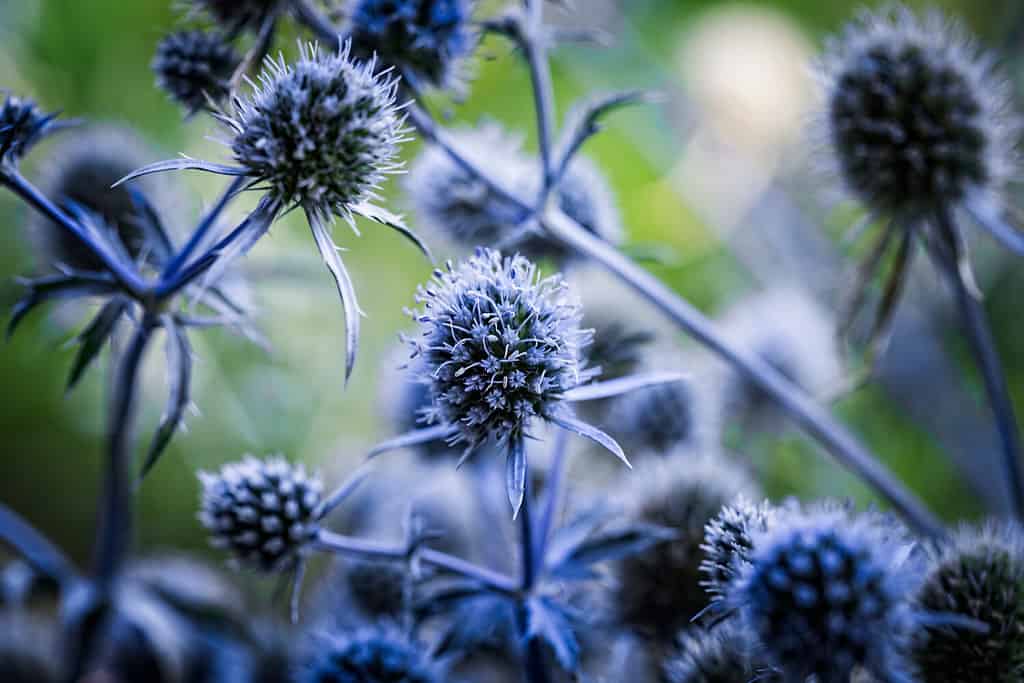
Sea holly grows in purple-blue foliage and blossoms. Some cultivars are a rare “true” blue!
©Kateryna Mashkevych/Shutterstock.com
While many “blue” flowers are actually purple shades, some cultivars of Eryngium planum achieve true blue. However, you’re more likely to notice the purple shades when you come upon them in the wild.
This unique wildflower is resilient, thriving in dry, undernourished soil and salty coastal patches. You can identify this flower by its distinctive shade, otherworldly jagged foliage, and clover-like heads. While these wildflowers may seem straight out of a Dr Seuss book illustration, you can find them in real life in Europe and Asia.
Sharp-Lobed Hepatica
Botanical name: Anemone acutiloba
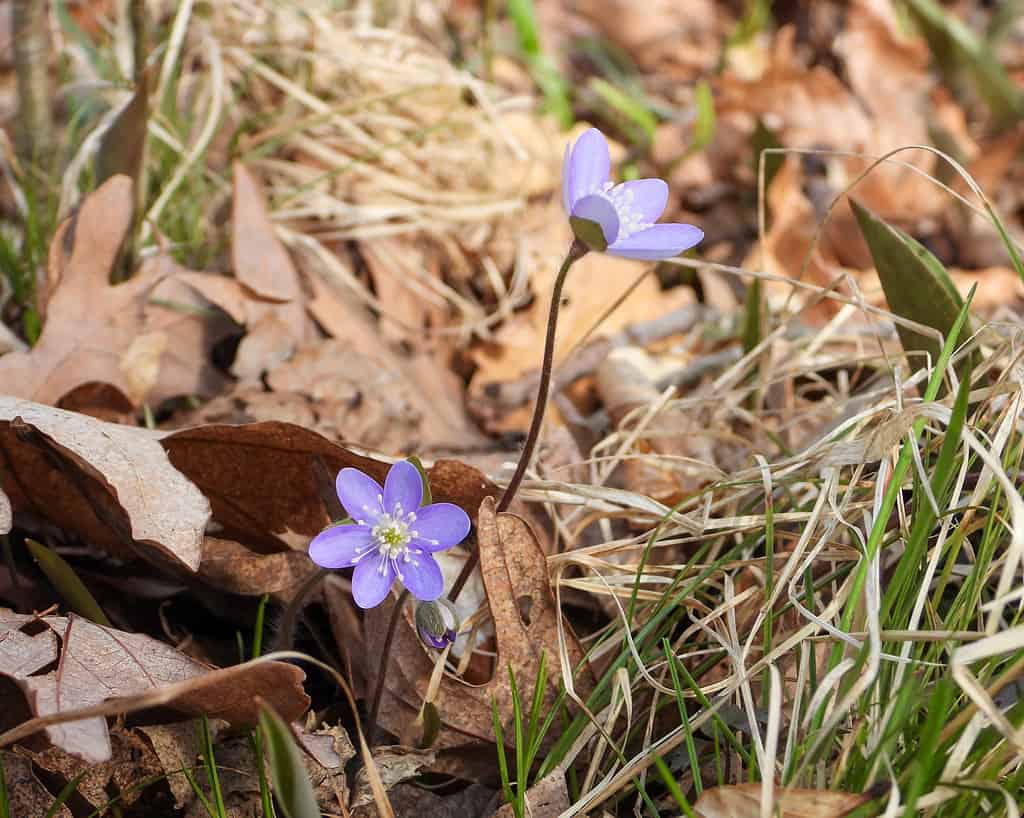
(Sharp-lobed Hepatica) is a Native North American springtime woodland wildflower.
©Brian Woolman/iStock via Getty Images
Despite the name, the Sharp-Lobed Hepatica has soft, rounded petals. You may also know this pretty purple wildflower as a Liverleaf. These pollinator-attractors bloom early in the spring and are often gone by the time most people start their outdoor adventures.
Bright yellow centers and white anthers punctuate delicate white-purple petals. These low-growers only reach a few inches tall, similar to many wild violet species. You can find these beauties throughout damp, wooded areas in Canada and the United States.
Shooting Star
Botanical name: Dodecatheon meadia
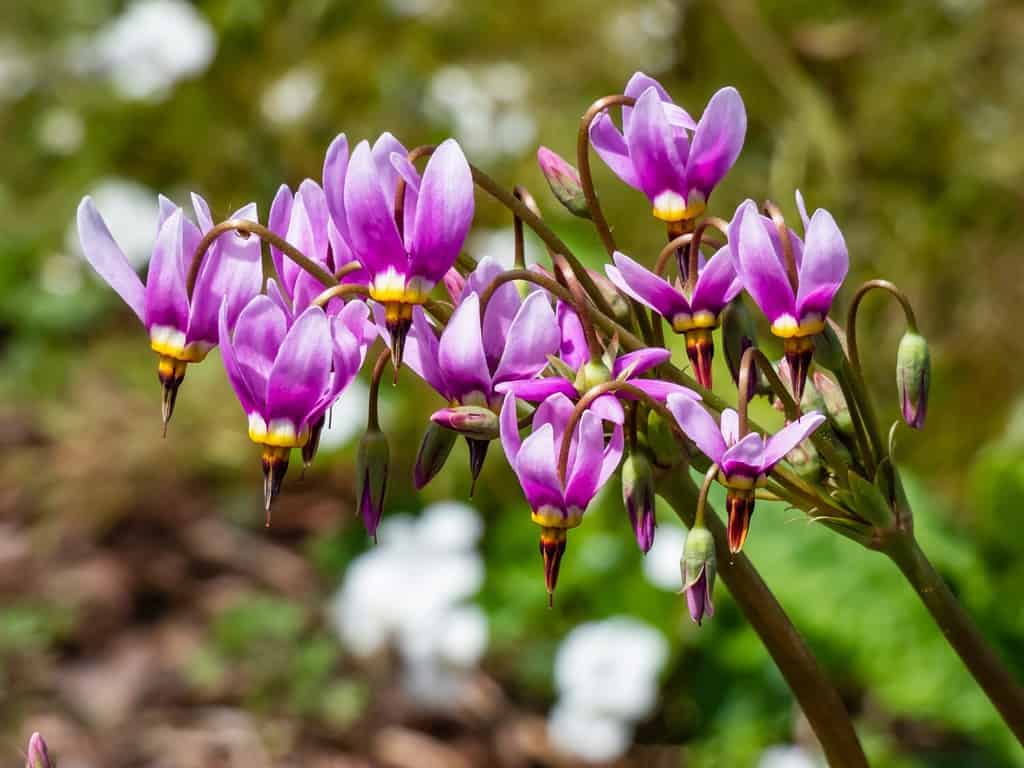
has a unique, chandelier-like appearance.
©Kristine Rad/Shutterstock.com
This stunning purple wildflower offers a unique combination of shapes and structure for a one-of-a-kind bloom that’s a treasure to behold. You can find this lovely wildflower in the Central and Eastern regions of the United States and parts of Canada.
The purple-pink flowers grow upward and curl in, while the yellow stamens grow downward away from the petals, tapering to a triangular point. You may notice several blooms on a single stem, which grows 1-2 feet tall in proper conditions.
A Summary of Types of Purple Wildflowers
| Types of Purple Wildflowers | Botanical Name |
|---|---|
| Alfalfa | Medicago sativa |
| American Hog-Peanut | Amphicarpaea bracteata |
| Aster | Aster spp. |
| Bee Balm | Monarda spp. |
| Bee orchid | Ophrys apifera |
| Blazing Star | Liatris spicata |
| Bull Thistle | Cirsium vulgare |
| Canada (Canadian) Thistle | Cirsium arvense |
| Clasping Bellflower | Triodanis perfoliata |
| Columbine | Aquilegia spp. |
| Common Burdock | Arctium minus |
| Common Camas | Camassia quamash |
| Common Phlox | Phlox spp. |
| Corncockle | Agrostemma githago |
| Dagger Pod | Phoenicaulis cheiranthoides |
| Early purple orchid | Orchis mascula |
| Eastern Coneflower | Echinacea purpurea |
| Eastern Smooth Beardtongue | Penstemon laevigatus |
| Fairy Slipper | Calypso bulbosa |
| False Foxglove | Agalinis tenuifolia |
| Field Scabious | Knautia arvensis |
| Foxglove | Digitalis purpurea |
| Giant Ironweed | Vernonia gigantea |
| Grass Widow | Olsynium douglasii |
| Great Blue Lobelia | Lobelia siphilitica |
| Harebell | Campanula rotundifolia |
| Hedgemaids | Glechoma hederacea |
| Hyacinth | Camassia scilloides |
| Lavender | Lavandula spp. |
| Meadow Garlic | Allium canadense |
| Meadow cranesbill | Geranium pratense |
| Monkeyflower | Erythranthe lewisii syn. Mimulus lewisii |
| Morning Glory | Ipomoea aquatica |
| Mother-of-the-Evening | Hesperis matronalis |
| Panicled Knapweed | Centaurea stoebe |
| Purple Prairie Clover | Dalea purpurea |
| Purple Toadflax | Linaria purpurea |
| Pyramidal Orchid | Anacamptis pyramidalis |
| Salvia | Salvia spp. |
| Saw-Wort | Serratula tinctoria |
| Sea Holly | Eryngium planum |
| Sharp-Lobed Hepatica | Anemone acutiloba |
| Shooting Star | Dodecatheon meadia |
| Showy Orchid | Galearis spectabilis |
| Spiked Loosestrife | Lythrum salicaria |
| Common Teasel | Dipsacus fullonum syn. Dipsacus sylvestri |
| Purple Toothwort | Lathraea clandestina |
| Veiny Pea | Lathyrus venosus |
| Verbena (Vervain) | Verbena spp. |
| Vetches | Vicia spp. |
| Violets | Viola spp. |
| Wild Geranium | Geranium maculatum |
| Wild Iris | Dietes Grandiflora |
| Wild Petunia | Ruellia humilis |
| Wisteria | Wisteria spp. |
The photo featured at the top of this post is © Kristine Rad/Shutterstock.com
Thank you for reading! Have some feedback for us? Contact the AZ Animals editorial team.






